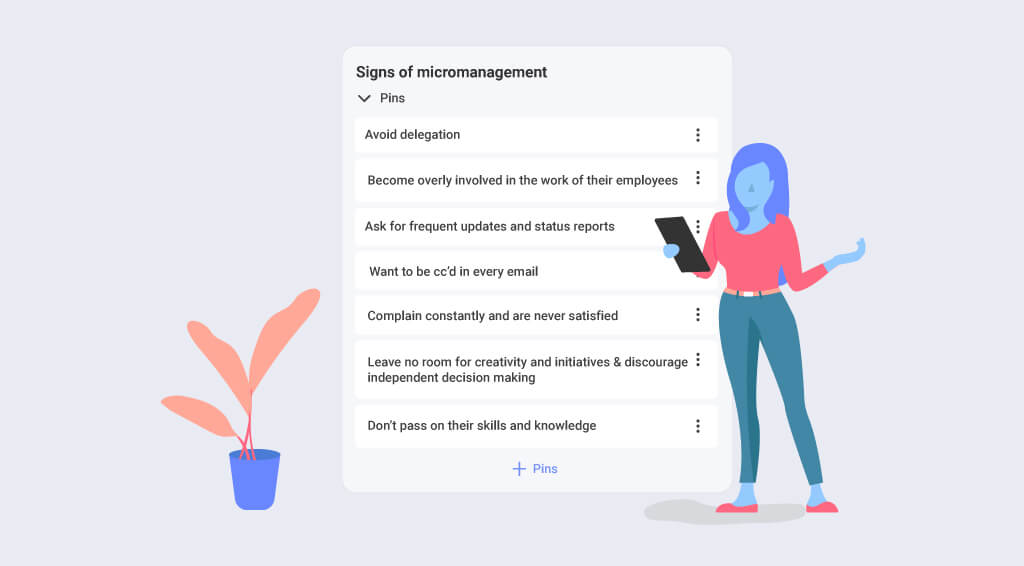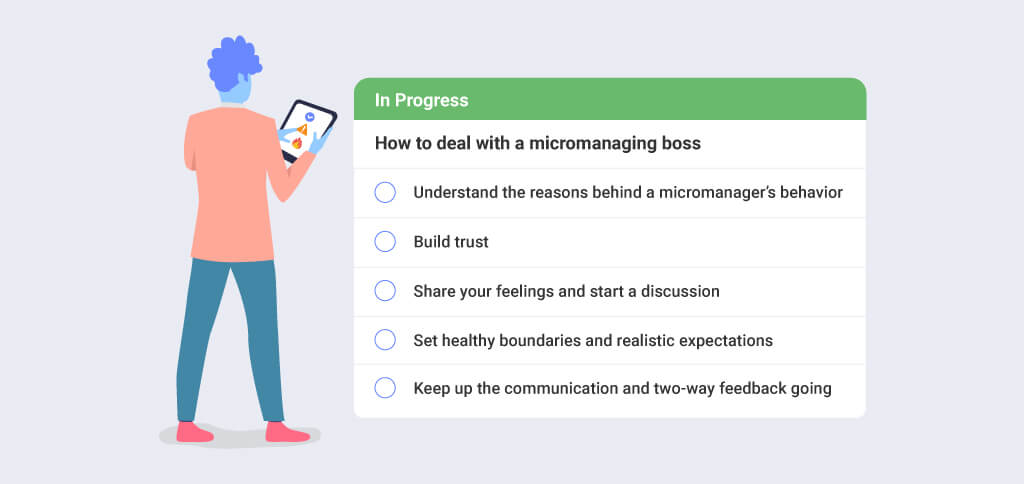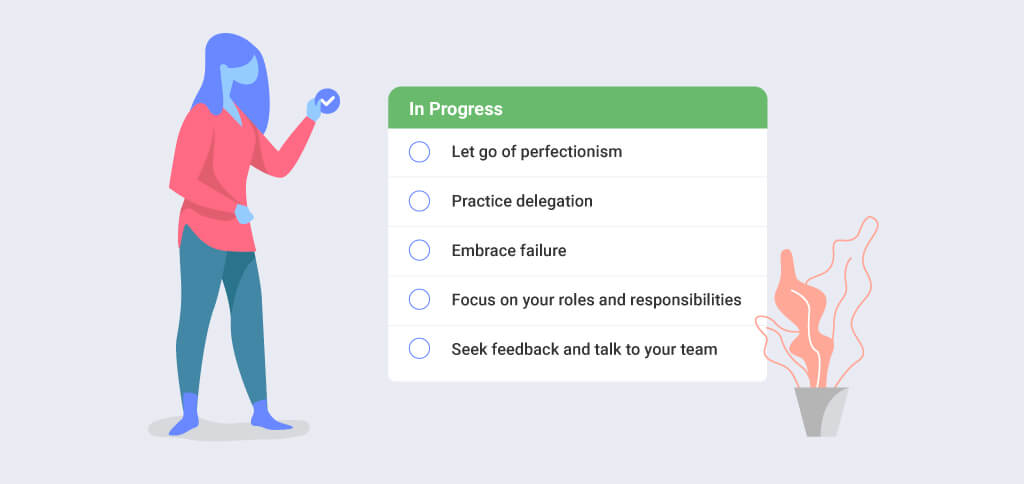
How Stephen Gould Scaled Its Capacity by 30% without Making a Single Hire
The first step in dealing with micromanaging is understanding the reason behind a micromanager's behavior. Find out what else you should do:
Nothing is more demotivating than having a micromanaging boss control every step of your daily workflow. A survey on micromanagement conducted by Trinity Solutions* showed that:
Are you part of those statistics?
Have you ever been or are you currently being micromanaged?
Do you consider that it is possible of being a micromanaging boss yourself?
If the answer is yes, then you’ve come to the right place.
In this article, we’ll be discussing micromanagement – what micromanage is, why people micromanage, what are the signs of micromanagement, how to deal with a micromanaging boss, and how to stop yourself from micromanaging others.
Micromanaging or micromanagement is a negative term that refers to management style. It is very well defined by Gartner: Micromanagement is a pattern of manager behavior marked by excessive supervision and control of employees’ work and processes, as well as a limited delegation of tasks or decisions to staff.
Micromanagers generally avoid giving decision-making power to their employees and are typically overly obsessed with information-gathering.
There is no straight answer to that question. People micromanage for a variety of reasons. These reasons can include different feelings and emotions such as fear of failure, extreme need for control and domination, inexperience in management, insecurities, unskilled team members, unhealthy ego, etc. Some micromanagers might be driven to act so obsessively due to problems that they have at home and in their personal life.
The most obvious and common reason for people to manage is, however, the lack of trust and respect in the people they work with.
If you’re wondering whether you’re being micromanaged or if you’re a micromanager yourself, here is a list of the most common characteristics that prove that:

Since micromanagers don’t believe that anyone can do a decent job, they avoid delegating tasks and doing everything themselves. Of course, that doesn’t work well for anybody, and micromanagers are not superheroes so obviously they need to get back down to Earth and realize that tasks should be delegated to the people that have the specialized skills needed and are qualified to produce the desired results.
Standing over someone’s shoulder watching their every move and checking in on things constantly is not effective – and let’s face it, it’s annoying. Many people freeze or feel a lot of discomforts when they are being constantly watched which results in stress and even errors.
Weekly check-ins and status reports on a reasonable cadence are standard. But, when updates are being asked on a daily basis, you can be sure that either you’re being micromanaged or that you’re being a micromanaging boss yourself. This obsession with constant updates results in wasted time that people spend creating detailed reports than focusing on what were they actually employed to do.
‘’And don’t forget to cc’d me in the email’’ – does that sound familiar? If yes, then this is a clear sign that whether you’re being micromanaged or that you are a micromanager yourself. This need to have visibility of every stand of communication at all times usually indicates that the manager is afraid of being left out of the loop, or that he’s thinking that others might be discussing details and making decisions behind his back.
Micromanagers complain about everything even when there’s nothing to complain about. But the thing is that when you’re always looking for mistakes and flaws in others, that’s all that you’ll find. Often these complaints could be about the smallest things that don’t even relate to the execution of tasks. Usually, the micromanagers would think that they only encourage perfection, but what they actually do is drain the motivation out of their employees.
Because they don’t trust others to do their job, micromanagers tell employees what to do without leaving room for creativity and initiative. Especially if your job is in the creative area, being constantly told how exactly a task should be done can be very frustrating and discouraging.
Giving freedom of independent decision-making is also unthinkable for micromanagers. While it’s likely that your work must go through some form of the approval process, that doesn’t mean that you shouldn’t make some decisions on your own in the process of your work. It is actually the quite opposite – you were hired because you are the most qualified person for that job and because the decisions that you can take based on your expertise could drive business growth.
Steve Jobs says: ‘’It doesn’t make sense to hire smart people and tell them what to do; we hire smart people so they can tell us what to do.’’
Managers can act as role models for employees that are just starting out their journey. But if that manager has zero interest in teaching juniors that can be not only disappointing but also very discouraging and daunting. Typically, after such a horrible experience in which juniors get to learn nothing, but in the meantime receive tons of complaints, that can make them give up or worst turn them into a micromanager in the feature.
No one wants to be micromanaged, going to work with despair, stress all day long, and being shouted at. The first step in dealing with micromanaging is understanding the reason behind a micromanager’s behavior. Here’s what else to do:

As we already mentioned, people micromanage for a number of reasons. To know how to proceed further and deal with your micromanaging boss, you first need to understand what triggers his behavior.
Maybe your manager is under a lot of stress too, maybe he’s had trust issues with previous employees or maybe it’s just his personality. To continue to the next step, you need to find out, so you can build trust and even help him overcome whatever it is that makes him act like that towards you and your teammates.
Trust is key to any healthy relationship whether that is love, friend, or work relationship, without trust it’s just a waste of time. If you want your boss to stop micromanaging you, you need to win his trust and show him that he can calmly delegate your tasks and give you the freedom of decision-making. Yes, we know that this is easier said than done, but that’s usually the case with trust – it’s hard to build, easy to lose.
You can try to demonstrate to your boss that he can trust you by delivering outstanding work (make sure to double or even triple-check everything before you submit) and regularly communicate your progress (don’t wait for him to ask, take responsibility). Sometimes building a personal relationship can also contribute to building and improving trust in the workspace.
That idea might be frightening at first, but one of the most direct approaches to dealing with a micromanaging boss is to simply share your feelings and start a discussion about the situation. Explain how his micromanaging behavior is negatively affecting your performance and overall workflow in an honest, polite, and calm manner. Don’t let anger take over you and don’t try to be defensive as this will not help you to improve the situation.
As part of the conversation above, it will be great to discuss and set healthy boundaries and realistic expectations. Establish clarity on the roles and responsibilities and expectations of you and your manager so there is no misunderstanding in the work process. Make sure to set boundaries too and let your boss know when he’s crossing them. That might also be frightening at first, but once all those things are communicated and lessons are learned, magical things in the workspace could happen.
Okay, so you’ve understood the reasons behind your manager’s behavior, you shared your feelings, discussed the situation, and worked towards building trust – great! But this is not the end. This is an ongoing process; you cannot change things overnight. You should constantly keep up the communication and two-way feedback going, so things don’t return to the way they were. Continue being proactive and talk to your manager to make sure that they’re happy with your output.
If you started reading this article because you’ve considered the possibility that you might be a micromanaging boss yourself, then by now you should already know the answer. If you’ve concluded that you are a micromanaging boss, don’t lose heart; micromanagement might be a hard habit to break, but with the right guidance, you can do it.

Follow our tips, work hard and the desired results will not be late.
It’s time to face the truth: perfection doesn’t exist. When you realize that, it will be far easier for you to stop micromanaging your team. There are various different methods to do a certain task or a project, so instead of telling your team how to do everything that you consider perfect, empower them to test new approaches and experiment with new ideas – you never know how they can surprise you.
As a manager, you should know the strengths of your team members so you can delegate tasks accordingly. If you are not able to delegate tasks effectively, then this is another reason for you to avoid doing it and micromanage everything that your team does.
In the beginning, you might make mistakes, but remember that practice is the hard part of learning, but also the essence of knowledge.
As hard as it might seem, the world won’t stop spinning if things don’t turn out as planned. Failure is success in progress and could be the best teacher. Don’t be afraid of it, welcome it, and instead of blaming and yelling at your team for it, teach them to embrace failure too.
Your job as a manager comes with its responsibilities. Rather than micromanaging every step of your employee’s workflow because you think that the only one that can complete a specific task successfully is you, give them a chance to prove their skills and focus on the activities that as a manager only you can do. Your job is to set clear objectives and benchmarks and measure performance, and that is what you should do.
If you want to have a strong relationship with your team, don’t be afraid to bring up the topic of your management style. Ask each individual on your team about feedback and ask them how they would like to be managed – maybe some will prefer your current micromanaging style, while others would want more freedom. Understand want your team wants and adjust to these needs.
Seamlessly manage tasks, teams, and projects of any complexity from start to finish.
Use Template →
Don’t get this article wrong – micromanagers usually have good intentions towards their employees and the work in general. The problem is that their behavior can impact team performance, and productivity, and even damage people’s health. That is why things in a micromanagement environment must change.
Objectives and key results (OKR) is a management technique used to set challenging, ambitious goals with measurable results. And although you can do that on a piece of paper, this is usually done with dedicated OKR software.
OKR software gives managers and team members visibility into the entire work process, connecting everyday tasks to the project’s most important objectives. This way, managers can spend less time managing and more time leading.
Slingshot is a productivity tool designed to help teams and organizations produce extraordinary results by improving workflow efficiency with a rich and robust set of integrated features, aligning teams around opportunities to encourage them to reach their full potential, and enabling smart, data-driven decision-making with advanced analytics.
Here are a few ways in which Slingshot deals with micromanagement:
If you want to learn more and see how it works, you can try it today for free and see how Slingshot can help your teams deliver extraordinary results that drive business growth.
*Source: Trinity Solution